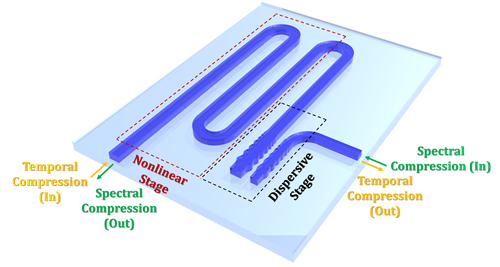Ultra-strong squeezing of light demonstrated for ultrafast optical signal processing
SUTD - Ju Won Choi, Ezgi Sahin, Byoung-Uk Sohn, George F. R. Chen & Dawn T. H. Tan
A*STAR - Doris K. T. Ng,
MIT - Anuradha M. Agarwal and Lionel C. Kimerling
Photonics researchers demonstrate 11-fold compression of light in time, introducing an important paradigm for light generation in advanced metrology, imaging and high speed optical communications.
 Schematic of the USRN compressor system. The system is comprised of separate nonlinear and dispersive stages. For spectral compression (SC), pulses enter the dispersive stage (DS) first before the nonlinear stage (NS), and for temporal compression (TC), pulses enter NS first before DS.
Schematic of the USRN compressor system. The system is comprised of separate nonlinear and dispersive stages. For spectral compression (SC), pulses enter the dispersive stage (DS) first before the nonlinear stage (NS), and for temporal compression (TC), pulses enter NS first before DS.
A train carrying cargo has finite space. The amount of cargo that can be carried onboard is limited by the size of the cargo and the capacity of the train. Analogously, the amount of time taken up by an optical signal limits the amount of data that can be carried. Temporally shorter signals allow more data to be squeezed into a given time duration, in a method called optical time division multiplexing. Photonics researchers have recently succeeded in squeezing light in time by 11 times. The developed temporal compression system allows an equivalent increase in the number of bits transmitted by light in a fibre optic network.
By leveraging analogous dualities in space and time, the same system also allows the frequency (or wavelength) content of light to be squeezed as well. For example, light that has red, yellow and blue colours will be spectrally compressed to only possess yellow light. The amount of colour in an optical signal also limits the amount of data which can be carried in a fibre optic network when wavelength division multiplexing is used. Consequently, this capability to spectrally squeeze light could allow higher spectral densities of light propagating in a specific medium.
Details of this work appeared in Light: Science and Applications on 18 June 2021, and was a collaboration between researchers at the Singapore University of Technology and Design (SUTD), A*STAR Institute of Microelectronics and the Massachusetts Institute of Technology. The ultra-small size of the compressor system (refer to image) provides several orders of magnitude smaller footprint compared to bulky, benchtop compressor systems used for generating short pulses in ultrafast optical signal processing.
The high compression achieved was made possible by the two-stage design featuring a dispersive element and strongly nonlinear component, both of which were integrated on the same chip.
“By balancing the contributions from the dispersive and nonlinear stages, we could generate strong compression in either time or frequency. The temporal compression is one of the strongest demonstrated to date on a chip. The spectral compression is also the first of its kind demonstrated on a chip,” said Dr Ju Won Choi, the research fellow who worked on this project.
Providing strong compression on such a small device footprint could facilitate low-cost deployment of short pulses needed in telecommunications, data centre, precision manufacturing and hyperspectral imaging.
“The demonstrated on-chip integrated system capable of both high temporal and spectral compression allows flexibility in the manipulation of optical pulses, an important capability as the burden on existing high-speed communications becomes more pronounced. The data center, telecommunications and 5G industries will require more and more capacity, and approaches such as these that help squeeze more light into a given medium will aid in this drive towards faster optical communications networks,” said Associate Professor Dawn Tan from SUTD who was the principal investigator of this work.
Acknowledgements:
This work was supported by the National Research Foundation Competitive Research Grant (NRF-CRP18-2017-03) and the MOE ACRF Tier 2 Grant. This work is a collaboration project between SUTD and IME (A*STAR).
Reference:
High spectro-temporal compression on a nonlinear CMOS-chip, Light Science & Applications. (DOI: 10.1038/s41377-021-00572-z)